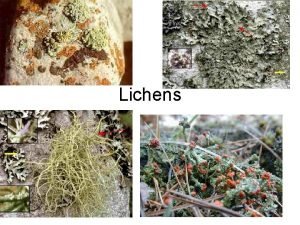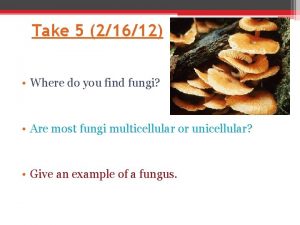Lichens Lichenicolous Fungi and Allied Fungi of Turnipseed

- Slides: 1

Lichens, Lichenicolous Fungi and Allied Fungi of Turnipseed Wake. Nature Preserve, North Carolina, USA Gary B. Perlmutter University of North Carolina Herbarium (NCU), North Carolina Botanical Garden CB# 3280, Coker Hall, University of North Carolina, Chapel Hill, NC 27599 Table 1. Lichen diversity of Turnipseed Preserve. Families in bold constitute a significant (>5%) portion of the biota. Introduction Turnipseed Preserve is 90 hectares of county-owned open space in eastern Wake County in the Outer Piedmont / Fall Line transition zone of east-central North Carolina (Fig. 1). It was recently designated a “Wake. Nature Preserve” by the local stakeholder group Wake. Nature Preserves Partnership by exhibiting high quality ecological resources with a written plan for their stewardship. Part of the inventory work that went into the site’s management plan was a lichen survey conducted in 2009 -2011. Family Figure 2. Acarospora janae K. Knudsen, newly described from specimens collected at Turnipseed in 2009 and Las Vegas, New Mexico, 1927 -1929 (Lumbsch et al. 2011). Results & Discussion Figure. 1. Map of Turnipseed Preserve, Wake County, North Carolina depicting preselected lichen sample sites (yellow dots). Methods & Materials Turnipseed was surveyed of its lichens through multiple visits to preselected sites, focusing on specific terrestrial habitats: forest edge of a powerline corridor, floodplain forests, mixed pinehardwood forest, pine-regenerating stands, granitic flatrocks, granitic boulder clusters / outcrops, and open fields (Fig. 1). At each site all lichen taxa encountered were recorded with 475 vouchers collected. Specimens were deposited at NCU and determined using standard laboratory techniques. The more difficult specimens were sent to outside experts for determination / further study. Data were analyzed by habitat type and subtype. To assess environmental health, documented pollution-sensitive and pollution-tolerant species were tallied and compared to other floras. Prepared for the 2011 American Bryological and Lichenological Society Annual Meeting, Roan Mountain State Park, Tennessee, June 20 -24, 2011. A total of 170 species were identified in 76 genera, representing 37 families (Table 1). The largest families include the Parmeliaceae, Physciaceae, Cladoniaceae, Pertusariaceae, and Graphidaceae, in descending order. The remaining 32 families each contain less than 5% of the biota. The lichen biota was 56% corticolous (96 taxa), 29% saxicolous (50 taxa), 11% lignicolous (19 taxa), 9% terricolous (16 taxa), 4% muscicolous (6 taxa) and 1% lichenicolous (2 species); 15 species were found on multiple substrate types. By habit, the biota is 55% crustose (93 taxa), 27% foliose (45 taxa) and 18% fruticose (31 taxa). Twelve new state records were found, including Acarospora janae (Fig. 2), new to science, and members of the family Lichenotheliaceae represented by lichenicolous and rock-inhabiting fungi (Fig. 3). Lichens were found throughout the preserve, in all habitats except open fields (Table 2). Mixed forests had the highest lichen diversities of any forest type, likely owing to forest stand variability in age and tree composition, plus a relatively robust floor component. Six pollution-tolerant (Candelaria concolor, Flavoparmelia baltimorensis, F. caperata, Physcia millegrana, Punctelia rudecta and Pyxine subcinerea) and ten pollution-sensitive (Coccocarpia palmicola, Collema subflaccidum, Leptogium austroamericanum, L. cyanescens, Nephroma helveticum, Ramalina culbersoniorum, R. americanum s. lat. , Usnea mutabilis, U. pensylvanica, U. strigosa, U. scabrosa) macrolichens were found with the tolerant species in more exposed habitats and the sensitive ones in shaded forests. Peltigera was notably absent. These findings suggest a moderate impact of ambient air pollution from local farms, roads and cities, yet support the notion that forests act as air scrubbers as wetlands do for water quality. No. genera No. spp. % biota Acarosporaceae 3 6 3. 53% Agyriaceae 2 3 1. 76% Arthoniaceae 2 6 3. 53% Arthopyreniaceae 1 1 0. 59% Candelariaceae 2 2 1. 18% Chrysotrichaceae 1 1 0. 59% Cladoniaceae 1 21 12. 35% Coccocarpiaceae 1 1 0. 59% Coenogoniaceae 1 1 0. 59% Collemataceae 2 3 1. 76% Fuscideaceae 1 1 0. 59% Graphidaceae 6 10 5. 88% Hymeneliaceae 1 1 0. 59% Lecanoraceae 2 6 3. 53% Lecideaceae 1 2 1. 18% Lichenotheliaceae 2 2 1. 18% Lichinaceae 2 2 1. 18% 56 Melaspileaceae 1 3 1. 76% 56 0 Monoblastiaceae 1 1 0. 59% Mycoporaceae 1 3 1. 76% Naetrocymbaceae 1 1 0. 59% Nephromataceae 1 1 0. 59% Ochrolechiaceae 1 1 0. 59% Parmeliaceae 11 27 15. 88% Pertusariaceae 1 12 7. 06% Phlyctidaceae 1 2 1. 18% Physciaceae 9 22 12. 94% Pilocarpaceae 3 3 1. 76% Porinaceae 1 2 1. 18% Pyrenulaceae 1 3 1. 76% Acknowledgments Ramalinaceae 3 5 2. 94% I wish to thank Nathaniel Osborne and members of Wake. Nature for inviting me to inventory Turnipseed Preserve; lichenologists at BM, GZU, HBG, MSC, NY and UCR for determining specimens; and the NCU curatorial staff for allowing space and equipment for identifying and curating specimens. Fieldwork was conducted under a permit by the Wake County Dept. Parks, Rec. and Open Space. Rocellaceae 1 1 0. 59% Sarrameanaceae 1 1 0. 59% Stereocaulaceae 1 5 2. 94% Teloshcistiaceae 1 2 1. 18% Trypetheliaceae 2 2 1. 18% Verrucariaceae 2 3 1. 76% Incertae sedis Totals: 1 1 0. 59% 76 170 Figure 3. Granitic boulder outcrops blackened by expansive colonies of the rockinhabiting fungus Lichenothelia scopularia. This taxon is currently under molecular study. Table 2. Lichen community composition within habitat type. Fl = floor, Un = understory, Ca = canopy, Ro = rock, Ma = mat, Tr = tree, Sh = shaded, Pt = partly shaded, Ex = exposed. Habitat Powerline Corridor (forest edge) Floodplain Forest Mixed Pine-Hardwood Forest Regenerating Pine Stand Granitic Flatrock Outcrops Open Fields 1 Percentages Subtype 1 Fl Un Ca 6% 59% 46% 9% 79% 24% 72% 29% 6% 68% 42% Ro Ma Tr 32% 29% 43% Sh Pt Ex 37% 59% 18% ---- Total 46 44 86 34 may total >100 per habitat type due to taxa growing in multiple habitat subtypes. Conclusions Turnipseed Preserve is found to have a rich lichen biota, which is likely attributed to the site’s diverse habitats with rocky abundance in a transitional ecoregion as well as an intensive sampling effort. Literature cited Lumbsch, H. T. et al. 2011. One hundred new species of lichenized fungi: a signature of undiscovered global diversity. Phytotaxa 18: 1 -127. For further information Please contact lushik@aol. com. Information on Wake. Nature and its efforts can be found on their website: www. wakenature. org. 37 100. 00%

